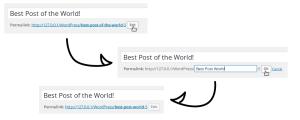I never understood the saying, “The more things change, the more they stay the same”—until the Internet came along, that is. In the mid-90s many of my fellow print designers were having fits because they had to learn to design for this new medium called The Web. Rather than easing our pain, print design publications of the day wrote articles about “the dreaded HTML” and used phrases like “those who dare to look at the source code…” like it was a foray into the Amazon rain forest. After designing my first site, I got angry over some of the articles I’d read, because it seemed that there were as many similarities as there were differences between print design and web design. I suppose scary headlines sell more magazines.
I did have a point. Bear with me as I try to find it. Oh yes, the more things change the more they stay the same. A couple of 23-year-olds recently told me how much they’ve seen technology change since they were kids. (Like what? Cells phones didn’t “flip” or “slide” and they watched Barney on VHS not DVD? When I was a kid … well, never mind.)
Fact is, a lot has changed in 10 or so years. In 2001, Facebook and the iPhone didn’t exist. Google (as a corporation) was just three years old, and AdWords was barely out of diapers. But one thing that hasn’t changed is human nature. Those early Internet companies who based their business model on the theory that “the Internet changes everything” found out it that didn’t—that eventually, investors expected them to become profitable. And even though the advertising world had been turned on its head, consumers haven’t really changed—at least not in the way they make purchase decisions. The acronym AIDA was coined over a hundred years ago to describe the buying process. It goes like this:
A – Attention
A product or service gets your attention.
I – Interest
You become interested and begin gathering information to support a purchase decision.
D – Desire
You gradually become more and more convinced that you want or need the product or service, at the price it’s being offered.
A – Action
You buy.
Just like there’s a buying cycle, there’s also a sales cycle. Some of the potential clients you meet will be “interested” in a website. Others will be “convinced” they want and need one (some more than others). The best ones are beyond convinced—they’re “ready to buy.” The only question remaining is, from whom?
Determining exactly where people are in the buying cycle can save you a lot of frustration and grief. It makes no sense to dress yourself in the appropriate business attire, then drive clear across town (or to an entirely different town) to meet with someone who’s merely “interested.” Ideally, you’ll want to meet with those who are in the “desire” or “action” stage of the buying process. But how can you tell?
In my next article, I’m going to talk about why you need a sales cycle. But don’t be too quick to meet with anyone who has a pulse and tells you, “I hear you build websites”. You ought to do some pre-qualifying first. A few simple questions will ascertain whether they have mild interest or a burning desire:
- Tell me a little about your business.
- What are you trying to accomplish with your site?
- Is it a top priority or a back-burner project?
Questions like these will get the conversation started and reveal exactly what you need to know. The further along the buying cycle they are, the better prospect they make. Understanding where your prospect is in the natural buying cycle will help you determine if and when to start the sales cycle, which, coincidentally, is the topic of my next article.
This is the first installment of the series “Understanding the Sales Cycle,” which consists of:
What’s a Buying Cycle and Why Should I Care?
What’s a Sales Cycle and Why Do I Need One?
Your Client is Ready to Buy, but Are You Ready to Sell?
Step 1, How to Prepare
Making a Good First Impression
 John Tabita
John TabitaFormer owner and partner of web firm Jenesis Technologies, John is currently Director of Digital Strategy at Haines Local Search, a company providing local search marketing solutions to SMBs, including print and Internet Yellow Pages, web design, and local SEO. When not working or spending time with his family, John offers great sales and marketing advice on his blog, Small Business Marketing Sucks. When not working or spending time with his family, John offers great sales and marketing advice on his blog, Small Business Marketing Sucks.


